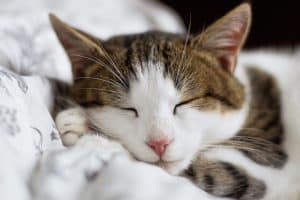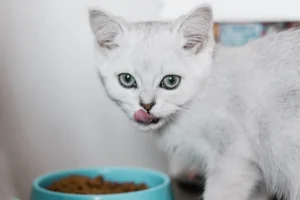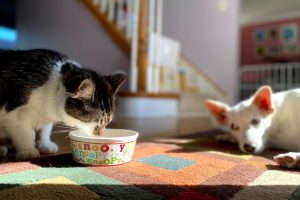Cats are often depicted in popular culture lapping up a bowl of milk, but have you ever wondered why this is the case? Let’s explore the reasons behind why cats are portrayed drinking milk.
Cultural Depictions and Misconceptions
Explore the history of cats drinking milk in popular culture and how it has contributed to the misconception of cats loving milk.
Cats and milk have long been associated in popular culture, dating back to ancient times when cats were domesticated. In folklore and children’s stories, cats are often depicted enjoying a saucer of milk, which has created a common misconception that all cats love milk. This portrayal has been perpetuated through various forms of media, from animated cartoons to advertising.
However, the reality is that many cats are actually lactose intolerant. Just like some humans, cats lack the enzyme lactase needed to properly digest lactose, the sugar present in milk. As a result, consuming milk can lead to digestive issues such as diarrhea and vomiting in cats, making it more harmful than enjoyable for them.
Overall, while the image of cats happily lapping up milk may be endearing, it’s essential to understand the biological and nutritional needs of cats. Providing water and a balanced diet specifically formulated for cats is the best way to keep them happy and healthy.
Lactose Intolerance in Cats
Contrary to popular belief, cats and milk are not always a harmonious duo. In reality, many cats struggle to digest milk due to lactose intolerance. This means that cats lack the necessary enzyme to break down lactose, the sugar found in milk, leading to potential digestive upset.
If you notice your cat experiencing gastrointestinal issues after consuming milk, such as bloating, gas, or diarrhea, it might be a sign of lactose intolerance. Opting for lactose-free alternatives or cat-specific treats can help prevent any discomfort for your feline friend.
Remember, while the image of cats drinking milk is charming, it’s crucial to prioritize your cat’s health above all else. Water will always be the best choice to keep your cat well-hydrated and happy.
The Myth of Whiskers’ Preference
Contrary to popular belief, not all cats are drawn to milk like moths to a flame. In fact, the idea of cats having an innate preference for milk is more fiction than fact. While some cats may enjoy the taste of milk, many cats are actually lactose intolerant and may experience digestive distress after consuming it.
When it comes to treats for your feline friend, it’s essential to choose options that align with their nutritional needs. Instead of offering milk as a treat, consider cat-friendly alternatives like tuna, chicken, or commercial cat treats designed for feline consumption.
By being mindful of your cat’s dietary needs, you can ensure they stay healthy and happy without the need for milk as a regular indulgence. Next time you reach for the milk carton, remember that cats and milk don’t always mix well together.
Address the common belief that cats have a natural affinity for milk due to a character like Whiskers in advertisements.
Contrary to popular belief, cats actually shouldn’t be drinking milk as a regular part of their diet. While television commercials may show cats lapping up milk happily, the reality is that many adult cats are lactose intolerant, meaning they lack the necessary enzyme to properly digest milk. Feeding your cat milk can lead to upset stomach, diarrhea, and discomfort.
The portrayal of cats drinking milk in advertisements is more about the imagery and association with cute and cozy domestic scenes rather than what is actually healthy for our feline friends. It’s essential to prioritize your cat’s health over these marketing tropes. Instead of offering your cat milk, opt for a clean bowl of fresh water to keep them hydrated and healthy.
Nutritional Needs of Cats
When it comes to the dietary requirements of cats, water is the best and safest option for maintaining their health. Cats are obligate carnivores, meaning their diet should consist mainly of animal-based proteins. While cats need protein, fat, vitamins, and minerals to thrive, they do not require milk as a regular part of their diet.
Providing your cat with fresh, clean water throughout the day is crucial for their well-being. Water helps with digestion, circulation, and temperature regulation. It is essential for keeping your cat properly hydrated and supporting their overall health. Instead of offering milk, focus on providing high-quality cat food that meets their nutritional needs.
Alternative Treats for Cats
Looking for alternative treats for your furry friend? Try offering small pieces of cooked chicken, tuna, or salmon as a tasty snack. These protein-rich options are not only delicious but also align with cats’ natural dietary requirements. You can also consider commercial cat treats that are specifically formulated to provide additional nutrients while still being tasty.
Adding variety to your cat’s diet can keep them interested and satisfied. Just remember to offer treats in moderation to avoid overfeeding and potential health issues. Treat time can be a fun way to bond with your cat and show them some extra love and attention. Consider trying different treats to see what your cat enjoys the most.
Provide a list of safe and healthy treats that can be offered to cats instead of milk for a special treat.
When looking to treat your feline friend to something special, it’s essential to consider their health and dietary needs. While cats may be commonly portrayed drinking milk in media, the reality is that many cats are lactose intolerant and can experience digestive issues if given milk. To keep your fluffy companion happy and healthy, here is a list of safe and healthy alternatives that you can offer as a special treat:
Cooked fish or poultry: Cats are natural carnivores, so offering them small pieces of cooked fish or poultry can be a delightful treat for them.
Catnip: This herb is a favorite among cats and can be given as a tasty and safe treat that will surely please your furry friend.
Freeze-dried meat treats: These crunchy and flavorful treats are a great option that mimics the texture of prey without the risks associated with raw meat.
Vegetables: Surprisingly, some cats enjoy nibbling on veggies like carrots or green beans as a healthy and low-calorie treat.
Commercial cat treats: There are numerous cat treats available in pet stores that are specifically formulated to be safe and healthy for cats, providing a convenient option for spoiling your pet.
Offering these alternatives to milk ensures that your cat can enjoy a special treat without the potential risks associated with dairy. Remember to monitor your cat’s reaction to new treats and consult with your veterinarian if you have any concerns about their diet.
Myths vs. Reality: Debunking Common Beliefs
The image of a cat perched contentedly lapping up a saucer of milk is a common trope in media and folklore, but the truth is that not all cats can digest milk properly. While some cats may tolerate small amounts of milk without issues, many adult cats are lactose intolerant and can experience gastrointestinal upset if given milk.
Contrary to popular belief, cats do not need milk as a dietary staple. In fact, water is the best and most important liquid for cats to drink to stay properly hydrated. Offering milk as a treat should be done sparingly and with caution, especially if you are unsure of your cat’s tolerance to lactose.
If you want to treat your cat, opt for safer alternatives like the ones listed above. Remember, it’s always best to prioritize your cat’s health and well-being over adhering to outdated myths and misconceptions.
Interesting Trivia: Famous Cats and Milk
Throughout history and popular culture, cats have been depicted enjoying milk in various forms of media. One of the most famous feline characters associated with milk is none other than the mischievous and beloved Tom from “Tom and Jerry.” Tom’s penchant for mischief often involved schemes to get his paws on a saucer of milk, perpetuating the idea of cats’ love for this beverage in the minds of many viewers.
Interestingly, in reality, many cats are actually lactose intolerant and may suffer digestive issues if given milk. This contrast between fictional portrayals and the truth about cats and milk highlights the importance of separating fact from fiction when it comes to understanding and caring for our feline companions. While the image of a cat enjoying a saucer of milk may be endearing, it’s essential to prioritize your cat’s health and choose safe and appropriate treats for them instead.
Garfield : This lasagna-loving feline from the comic strip and animated series has been shown enjoying a saucer of milk alongside his indulgent meals.
Tom from “Tom and Jerry” : This mischievous cat often portrayed lapping up milk from a saucer, adding to his classic cat persona in the beloved cartoon series.
Hello Kitty : Despite not having a mouth, this iconic character is often seen with a milk bottle, symbolizing purity and innocence in Japanese pop culture.
Sylvester : Known for his pursuit of Tweety Bird, this classic Warner Bros. character is frequently shown drinking milk in various Looney Tunes cartoons.
Extra Tip : While these fictional cats may enjoy the occasional milk treat on-screen, it’s important to remember that real-life cats don’t necessarily need milk in their diets and can sometimes be lactose intolerant.
Healthy Hydration: Importance of Water for Cats
Cats are notorious for being finicky drinkers, but proper hydration is crucial for their overall well-being. Water plays a key role in maintaining essential bodily functions, aiding digestion, regulating body temperature, and ensuring healthy kidney function. Since cats are descendants of desert-dwelling ancestors, they have a low thirst drive compared to other animals, making it essential to encourage and monitor their water intake.
Staying hydrated helps prevent urinary tract infections, dehydration, and other health issues in cats. Encouraging hydration can be done by providing fresh, clean water in multiple locations around the house, investing in a cat water fountain to entice them to drink more, and incorporating wet food into their diet.
Remember : Cats are obligate carnivores, meaning their bodies are designed to get most of their water intake from their food. Adding wet food to their diet can help increase their overall water consumption, promoting better hydration and supporting their health.
Nostalgia vs. Reality: Reassessing Portrayals of Cats and Milk
In various media, cats have been depicted enjoying milk, creating a nostalgic image of a content feline lapping up a saucer of dairy. However, it’s important to reassess this portrayal in light of scientific knowledge. Contrary to popular belief, many cats are lactose intolerant and can experience digestive upset from consuming milk.
While cats may enjoy the taste of milk, it’s best to offer them fresh water instead to ensure proper hydration without risking gastrointestinal issues. If you want to treat your cat, there are specially formulated cat milks available that are lactose-free and safe for feline consumption.
Unique Insight : Realistically, cats and milk may not always mix well, but there are plenty of other ways to show your furry friend love and affection without the risk of upsetting their sensitive stomachs. Prioritizing their health and well-being by providing appropriate nutrition and hydration is key to fostering a happy and healthy relationship with your feline companion.
The Surprising Connection Between Cats and Milk
Contrary to popular belief, many adult cats are actually lactose intolerant, meaning they lack the enzyme necessary to properly digest lactose, the sugar found in milk. While kittens can digest their mother’s milk due to a special enzyme they possess, this ability diminishes as they grow older. Feeding your adult cat milk can lead to digestive issues like diarrhea and upset stomach, so it’s best to avoid giving them this treat.
Interestingly, the association between cats and milk may have originated from a time when milk was a valuable and rare commodity. Cats were drawn to the scent of milk and would naturally be curious about this rich drink. Over time, this behavior became ingrained in our perception of cats enjoying milk. However, it’s essential to understand that for most cats, milk is not a suitable or healthy beverage.
In light of this new information, it’s crucial to reevaluate our perceptions and myths surrounding cats and milk. While the image of a cat lapping up milk is a common trope in media, it’s important to prioritize your feline friend’s health and well-being by avoiding offering them milk as a treat. Opt for specialized cat-friendly treats or foods that cater to their nutritional needs instead.
Encourage readers to reevaluate their perceptions of cats and milk in light of new information about feline nutrition
- Cats and milk: A common misconception
- Adult cats are lactose intolerant
- Milk can lead to digestive issues in cats
- Choose alternative treats for your feline friend
Understanding Feline Behavior and Nutrition
Have you ever wondered why some cats are enamored with milk, while others couldn’t care less? The answer lies in understanding feline behavior and nutrition. Cats are notorious for being picky eaters with unique dietary requirements. While milk may seem like a harmless treat, it can actually do more harm than good for your furry friend.
In the wild, cats are obligate carnivores, meaning their diet primarily consists of meat. They have evolved to obtain all the necessary nutrients from their prey, making milk an unnecessary addition to their diet. Additionally, many commercial milk products contain additives and sugars that can be harmful to cats, especially those with sensitivities or allergies.
To ensure your cat remains healthy and happy, focus on providing them with high-quality, species-appropriate food that meets their nutritional needs. Treats specifically formulated for cats are a better option than offering them milk, which can cause digestive issues and discomfort. By prioritizing your cat’s well-being and understanding their unique dietary requirements, you can help them thrive and live a long, healthy life.
The Truth About Cats and Milk
Many people associate cats with sipping on a saucer of milk, but the reality is a bit different. While it’s true that cats enjoy the taste of milk, most adult cats are actually lactose intolerant. This means that their bodies have difficulty digesting lactose, the sugar present in milk. Giving your cat milk can lead to upset stomachs, diarrhea, and other digestive issues.
So, why are cats often shown drinking milk in media and cartoons? This popular image likely stems from a time when milk was a more common household item, and cats were often found sneaking sips from their owners’ dairy products. While the image is cute, it’s important to remember that real-life cats may not react well to milk.
Understanding Your Feline Friend’s Needs
Cats are obligate carnivores, which means their bodies are designed to thrive on a diet rich in animal proteins. While cats may enjoy the taste of milk, it isn’t a necessary part of their diet. In fact, a well-balanced cat food provides all the nutrients that your feline companion needs to stay healthy and happy.
Want to treat your cat without upsetting their stomach? Consider offering lactose-free cat milk, which is specially formulated to be gentle on your pet’s digestion. Remember, moderation is key when it comes to treats – even the feline-friendly ones!
Tips for a Happy, Healthy Cat
- Hydration is key: Always make sure your cat has access to fresh water to stay hydrated.
- Choose high-quality cat food: Look for options with plenty of protein and minimal fillers.
- Regular vet check-ups: Schedule yearly visits to ensure your cat is in good health.
- Playtime: Cats thrive on mental and physical stimulation, so make time for play and interaction.
By understanding the myths and realities surrounding cats and milk, you can provide the best care for your feline companion. Remember, a healthy diet tailored to your cat’s needs is the key to a long and happy life together.
Alex, a passionate animal lover, has experience in training and understanding animal behavior. As a proud pet parent to two dogs and three cats, he founded AnimalReport.net to share insights from animal experts and expand his knowledge of the animal kingdom.









